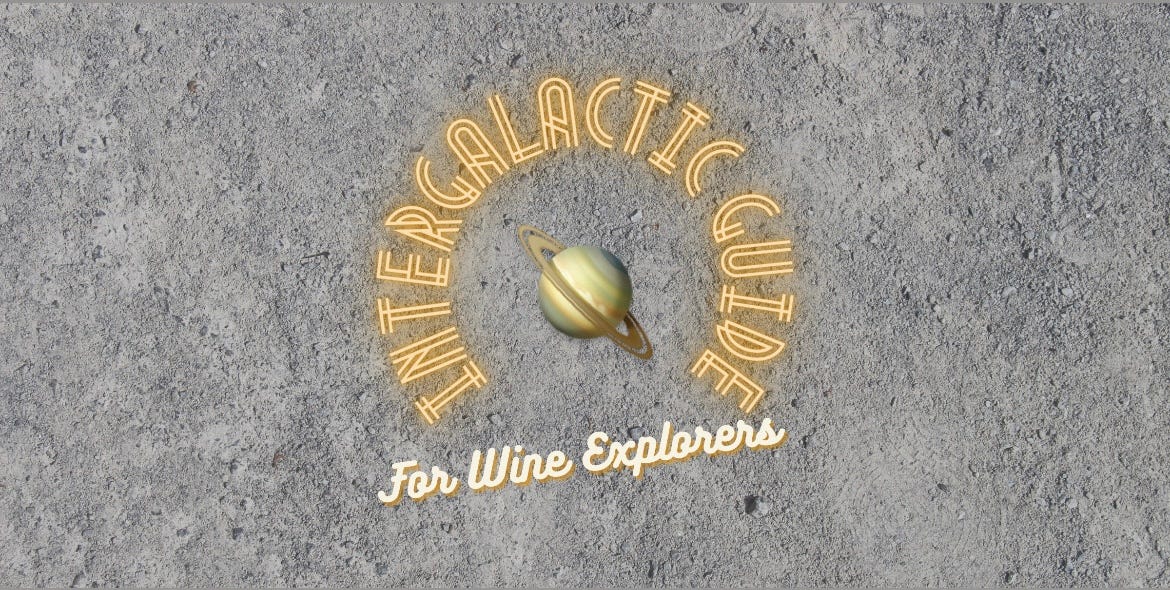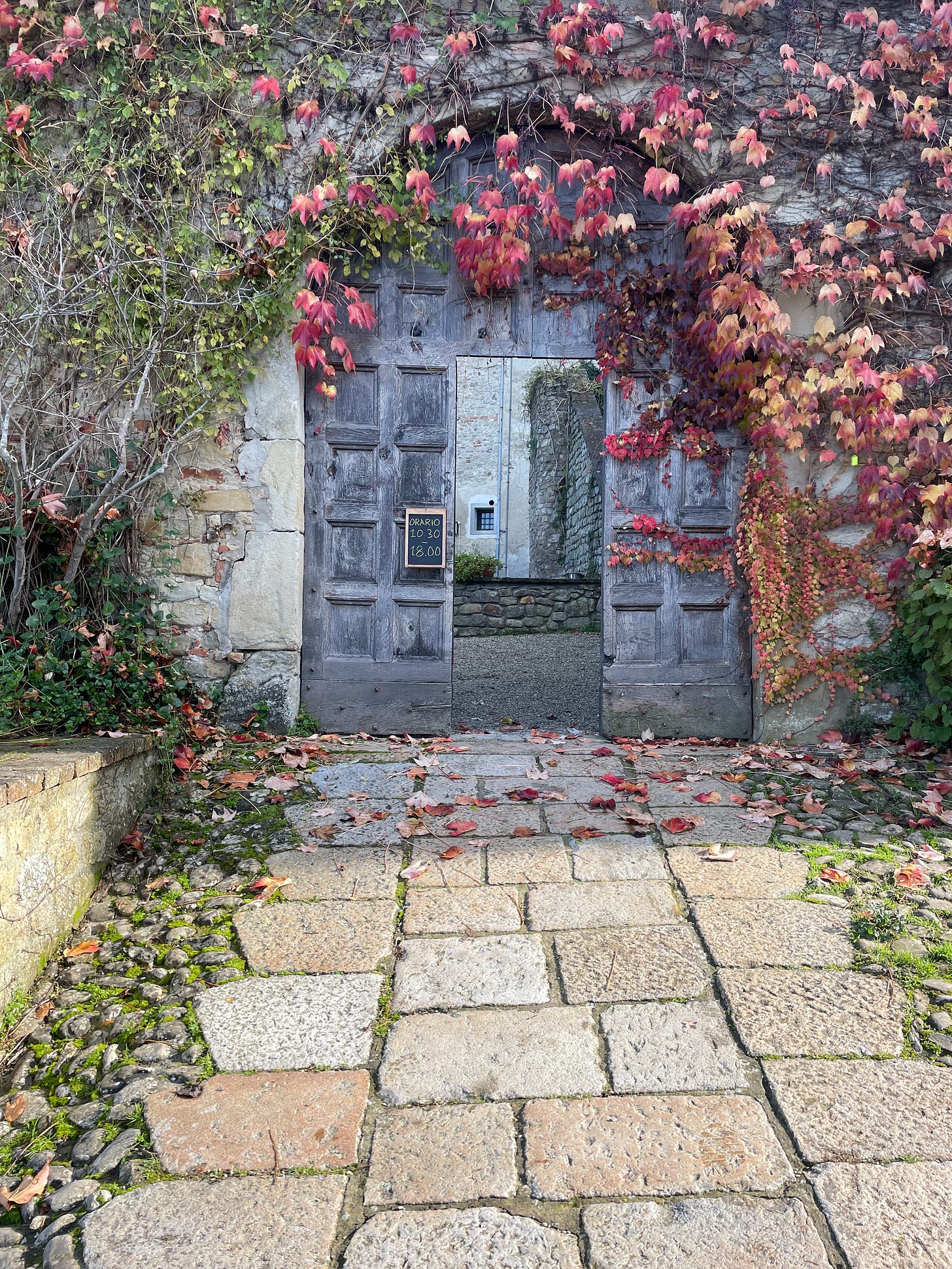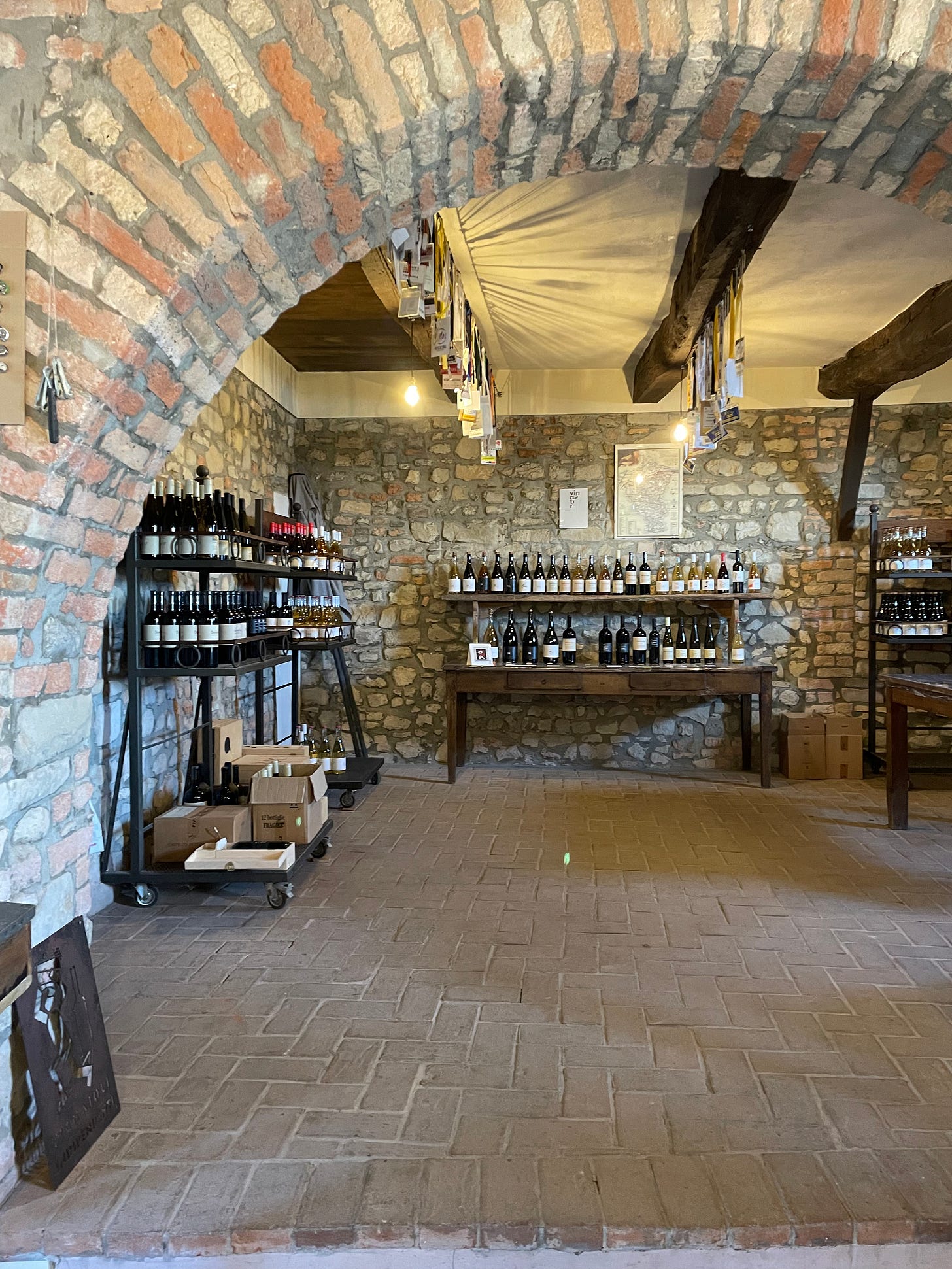On tasting on your own
S2 E11 | Have you ever heard of Borgoratto Mormorolo? Have you ever tasted a Pinot Grigio produced with grapes at three different stages of maturation? Have you watched Sorrentino's latest movie?
Ciao! I'm Giulia and this is the second season of the Intergalactic Guide for Wine Explorers: the newsletter that helps you connect the dots in the wine universe, a couple of bottles / songs / words / random stories / links per month.
If you found this episode by chance, or it was sent to you by a friend, you can quickly subscribe by clicking on the link below:
I will try to translate all previous episodes, but it is going to take some time, as I’m not that fluent in English anymore.
🚀 Pavia-Naples, round trip
As I was walking down the street, surrounded by the thick fog of Pavia, I had sort of a mental stumble: the kind of feeling you get when an unexpected thought crosses your mind and, like a lightning, it lights everything up.
I had just left the splendid Politeama theatre, after seeing Sorrentino's latest movie, "Parthenope" – by minute ‘10 (when they mention porridge) it had already won me over, but that's a whole another story.
As I kept walking, numb from the cold and the crazy humidity, it struck me: sharing is always the key – with ourselves and with others, even when we don't realize it.
How many things we avoid doing, just because no one is willing to come with us? How many things we avoid doing, fearing that people would judge us, seeing us taking part in any event by ourselves?
Therefore, knowing that I would be alone for a whole day in Pavia, I emailed a large number of wineries: only one got back to me (this is not a reality show this is my life). That was it: I would go and enjoy a wine tasting by myself at Castello di Stefanago.
☀️ Castello di Stefanago: a thousand shapes of Oltrepò
As I climb the hills that lead from the charming Borgoratto Mormorolo to the small village of Stefanago, all I can think about is “Please god don’t make the car stop”
Considering the fact that I've already gotten lost a couple of times and Castello di Stefanago is the only winery that was available for tasting, I wouldn't be too surprised.
As I get closer to my destination, the fog thins out, giving way to a timid sun and a much less timid foliage – there is a nostalgic charm in autumn that probably warms only the hearts of us, who were born in autumn.
I park my car, take my beloved notebook and set off to live this experience by myself: if I think about it, I can’t believe this is the first time I've gone tasting by myself, after so many years as a sommelier / wine industry insider.
I am welcomed by a very kind hospitality manager, who shows me the company's impressive product portfolio, divided into two lines: Stefanago and Stuvenagh.
She explains to me that Pinot Noir reigns supreme in the area of Oltrepò, followed by the indigenous grape “Croatina”. I nod and I understand why, but I also know very well that I am here today (instead of being immersed in the steamy water of some random wellness centre in Pavia) only and exclusively for their riesling.
You should know that this is a special area for this grape variety: here, riesling can express itself in very nuanced ways.
It’s actually Jack - with whom I would have also gladly chatted about tattoos, given all the art and ink he had on him - who leads me in the tasting.
He lets me taste 12 wines, starting from the young and joyful sparkling ones - made with the ancestral method - to the more bourgeois reds and last but not the least, my favorite and long-awaited rieslings.
I want to point out that I am not that reckless and I obviously spat every single sip of wine into a spittoon; I care about my driving license and, in general, about my life.
Golden rule: for every glass of wine you spit out, drink a glass of water. Remember to ask for directions to the loo.
What did I like the most about Castello di Stefanago?
🟢 The attention to sustainability, as underlined by their affiliation to the Vinnatur association (they follow a more stringent protocol in terms of what wineries can do, both in the vineyard and in the winemaking process, compared to the organic certification – which is now as useful as not having it).
💡 An eye for innovation: 15 years ago they planted Bronner vines, which is a PIWI vine, an hybrid variety which is way more resistant to pests and diseases than standard vines. For this very reason, a lot of talking is going on about PIWI these days, particularly in relation to their role in tomorrow’s wine world – as climate change gets more serious than ever.
🔬 Constant experimentation: from ancestral method sparkling wines to more classical whites, from orange wines to carefree reds, up to more tannic ones - they produce many different wines. It’s obviously a way to grab the attention of as many consumers as possible, but I like the approach. An example of this is the Pinot Grigio produced with grapes at three different stages of ripening: early picked, full ripe and overripe.
🪐 A wine from Castello di Stefanago
🍾 Spumante “Cuvée”, Ancestral Method, 100% Pinot Nero
🦞 When to drink it: to celebrate the end of yet another pro-fascist government, Elon Musk going bankrupt or, more simply, any Friday night before the bank holiday
🎮 For my wine nerds:
At the end of disgorgement, this wine is topped up with Chardonnay riserva, aged in acacia tonneau.
This wine reminded me of how well Chardonnay and Pinot Nero go hand in hand: I had just finished tasting the Ancestral Method Rosé (100% Pinot Nero), which had a completely different drinkability - Pinot Nero can be a wild beast, I often imagine it as a wild boar running around.
In this case, the addition of Chardonnay contributed with the right amount of smoothness and roundness to achieve a delicate sparkling wine, which leaves its mark, while caressing the palate.
Think of an elderly couple walking down the street, arm in arm: they support each other, one step at a time. They slowly walk, together, through life or down the street. This wine is just like that. It reveals itself slowly, supported by a well-established yet never dull balance.
☄️ Another wine from Castello di Stefanago
🍾 Riesling dell’Oltrepò Pavese “San Rocco”, vintage 2013
🦞 When to drink it: perfect for converting your heretic friends who only drink red wines and think that white wines are not worthy of their noble palate
🎮 For my wine nerds:
Jack explained me that, with a political trick worthy of our best governments, wineries are now allowed to simply write “riesling” on the back label, without specifying whether it is an “Italic” riesling or a “Rhine” one.
The thing is, a Rhine riesling is capable of somersaults in space and time that an Italic riesling can only dream of. Of course we don’t even come close to the quality level that can be reached in certain areas of Germany, but there is still a big difference.
This riesling - the very last vintage bottled with a cork - is obtained with Rhine riesling grapes. It is still alive and vibrant, thanks to the acidity able to defy the years, but obviously it leans much more towards the tones of oxidation and is softened by oxidative warmer notes.
🎷 A1, It’s just a burning memory, The Caretaker Spotify | YouTube
And so while I was walking back from the theatre to my car later that night, surrounded by the fog in Pavia, I thought about how marvelous it is to taste by myself and dedicate my complete focus to it, to feel full despite having spat everything out.
I thought that it is just as marvelous as it is to firmly believe that we’re doing something alone, only to discover that the boundary of shared participation is a thin line that goes beyond our own individual perception. Discovering that the act of sharing transcends and goes beyond our intentions.
Just like the old, unknown lady who was sitting next to me at the theatre: as the credits rolled at the end of the movie, she looked me in the eyes and asked me if I had liked the acting, what were my impressions of the scenography, if, in my opinion, Parthenope was actually a tribute to the city Naples.
Just like that: as if we actually had gone to the movies together.
💫 Wine for thoughts
How does the Ancestral Method work?
Producing sparkling wines following the Ancestral Method involves only one fermentation - unlike the Methode Champenoise, or the Charmat Method. The fermentation is influenced by temperatures.
These are the key ingredients:
🍇 Spontaneous fermentation, which starts without the inoculation of selected yeasts. The indigenous yeasts found on the grape bunches are the starters of the fermentation.
❄️ Hibernation, that is, following temperatures drop in winter, the yeasts go to sleep and fermentation stops: at this point there’s always a fairly consistent sugar residue.
🌸 With the arrival of spring, the must is bottled and - thanks to the rising temperatures - fermentation starts again: that’s when yeasts finish their job of transforming the sugar residue (or most of it) into carbon dioxide and alcohol.
🪐 Have you ever wondered how to take your first steps in exploring the world of wine, without the typical awe that goes with it?
I am shaping the Intergalactic Guide for Wine Explorers into a series of evenings dedicated to the discovery of one’s personal taste, an introduction to wine that does not aim to train future sommeliers, but conscious drinkers: taking the first step and nurturing one’s curiosity for a conscious approach to wine.
🛰️ Update: I have structured all the contents of the course 🥹 It's time to give torment to literally everyone around me to get their opinions and comments, as well as to build the digital environment where the course will take place. And then it will be time to contact the restaurants. The course will be primarily online, but at this stage I wouldn't rule out an in-person version (maybe less frequently than the online version).
(The real good news is that maybe I can finally stop waking up at 5:30AM every single day)
👉🏻 For obvious reasons, the course is only going to be in Italian. But if you still would like to give me suggestions or hints to help me build it, I would be immensely grateful. You can do so by leaving a comment or sending me a DM on Instagram.
🌒 Links worth sharing
This time around most of the articles I read and found thought-provoking are written in Italian. If you’re interested, you can find those in the Italian version of this episode.
Youngsters think wines are not well presented in restaurants. You don’t say! I can only agree with them. Read the article on Wine Industry Advisor.
🌍 Q&A
Do you have a question for me but don't have Substack to leave a comment? Would you like to talk about something specific? Or perhaps recommend me a botte of wine, or a winery to visit?
📨 Send me an email! Don’t be shy: I always enjoy reading your points on view, takes, questions.
That's it for this month: thank you very much for your time.
If you enjoyed this episode of the Intergalactic Guide for Wine Explorers, you could share it with your friends or acquaintances who might also be interested in the project:
If you have anything to ask, or doubts, you know where to find me: I’m always happy to talk about wine, down below in the comments section, or on Instagram.
Until next time.
Ciao!









